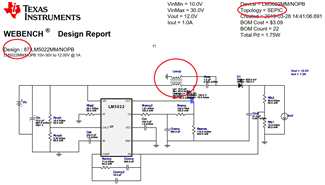Hello,
I'd like to create DC-DC converter in SEPIC topology with adjustable output voltage that can be controlled by MCU powered by 3V3 (with digital rheostat or DAC) .
Requirements:
- input voltage: 10-30
- nominal input voltage: 20 (in most cases this voltage will be as input)
- output voltage: adjustable in range 3-24 (with digital rheostat or DAC)
- nominal output voltage: 12V (in most cases this voltage will be used on output)
- output power: 12W
- voltage logic of MCU used to control output voltage = 3V3
I've already built and tested SEPIC converter based on LM5022 (webench.ti.com/.../webench5.cgi
SEPIC_None&topology=SEPIC&optFactor=3&VinMin=10&VinMax=30&O1I=1&O1V=12&op_TA=30&application=
SWITCHER&origin=ti_panel) and I'm wonder if it is possible to simply modify it to meet above requirements.


